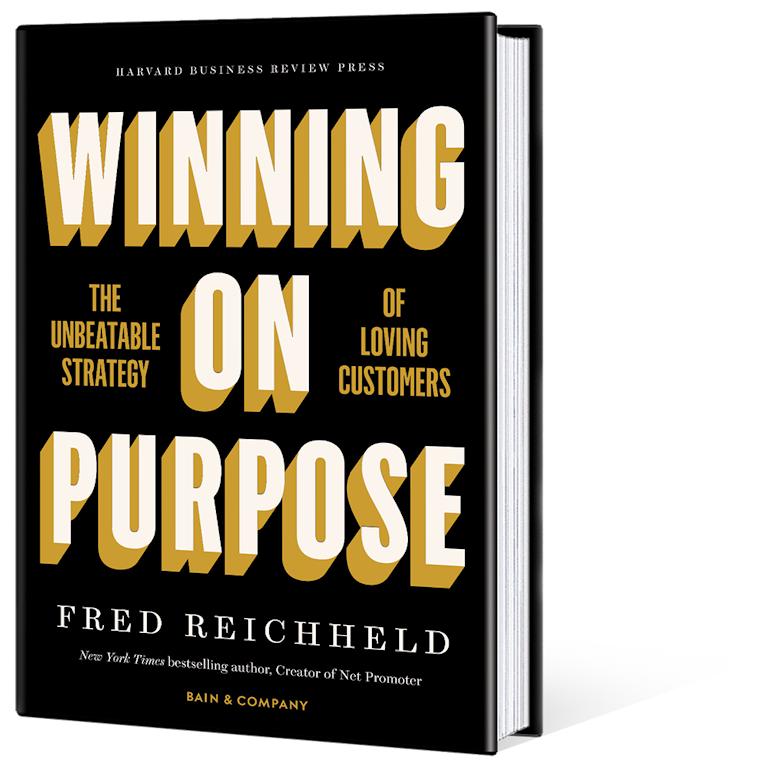
This article originally appeared on LinkedIn.
The Net Promoter Score made its debut in Harvard Business Review in 2003. In the years since, it’s enjoyed broad adoption—today the score is used by two-thirds of the Fortune 1000. Just as exciting is the way companies that weren’t so much as a twinkle in their founders’ eye 18 years ago are now using NPS to help create digital solutions that upgrade, and often fully reimagine, customers’ experience.

Winning on Purpose: The Unbeatable Strategy of Loving Customers
This new book by Fred Reichheld, Darci Darnell, and Maureen Burns demonstrates that great leaders embrace a higher purpose to win, and Net Promoter® shines as their guiding star.
Few companies have done a better job of this than Warby Parker, which over the past decade has revolutionized the purchasing process for glasses and contact lenses. Warby’s founding team of four Wharton MBA students (two of whom are Bain & Company alums) put the Net Promoter philosophy of aiming for remarkable at the heart of its new business model.
As we write in our new book, Winning on Purpose:
The founders saw an industry locked into the old-school mentality of charging the highest possible price, marketing aggressively through a commission salesforce, while providing mediocre service. Inventory was locked away in glass cases so the frames could only be inspected with the help of a commission-driven salesperson ... Warby figured out that by eliminating commissions and marketing overhead, they could profitably offer a pair of custom prescription glasses for $95, while the industry was selling that same product for $400–$500.
However, Warby’s goal was not to compete on price; it was to create enthusiastic promoters by delivering wows throughout the customer experience. To do this, the company completely reimagined every step in the customer journey.

Customer Love Quiz
Learn how customer-centric your organization is today and receive practical suggestions for how to move forward on the path.
Here’s how it works: An easy-to-navigate website helps each customer find a group of frame options. Then, for no charge or obligation, Warby sends a box of your five top choices, which arrives in a couple of days. You can try these on in the comfort of your own home, check them out in the mirror, and gather opinions from family members and friends. Order the winner, and then return the sample frames in a prepaid shipping box. New frames with custom lenses arrive a few days later. In the box, there is a reminder that, thanks to your purchase, Warby is distributing a new pair of glasses to someone in need.
Warby’s stated goal is to “treat customers the way they’d like to be treated—with warmth, helpfulness, empathy, and incredible service.” I asked co-CEO (and cofounder) Dave Gilboa how the company measures progress against this lofty standard. He said that to bring vitality to such a purpose you must be able to measure progress toward it, and he explained how they use the Net Promoter Score both to build a brand that customers love and to understand the long-term health of the company. Most of Warby’s new customers come through recommendations from existing customers, he told me.
Executives foster empathy with customers and frontline teams by regularly doing side-by-sides with customer service reps. They also visit Warby’s stores regularly, soliciting team and customer feedback in person. This helps them stay close to current customers’ concerns. And perhaps even more important, the executives experience the challenges—some of which are exacerbated by ever-changing systems or manual processes—faced by frontline employees in providing good customer service. Experiencing this frustration in person leads to more rapid solutions.
Warby carefully tracks NPS for all customer segments and monitors the relationship between customer NPS and the time from the moment a customer places an order for eyewear until its ultimate delivery. The company has found a very direct relationship between the length of this fulfillment cycle and how many customers provide promoter scores. This data drives decisions on how much the firm invests in expedited shipping. Warby’s target is to ensure shipping times that drive NPS ratings above 80%.
Recently the Wall Street Journal included Warby in an article about IPOs in the pipeline, noting that publicizing their noble ways is particularly beneficial to consumer-facing companies and those competing for talent, two groups who value this approach to business. The formula seems to be working for Warby Parker. Only a decade after its founding, private investors now value the company at $3 billion.

